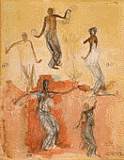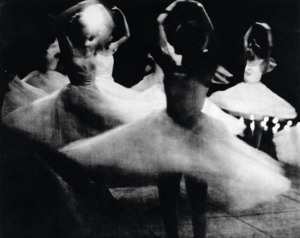Jane Hall was inspired by Latin American and ballroom dancing.This piece, entitled Waltz, shows a man and woman in a ballroom dance. The two people appear to be moving together in a waltz. http://www.jane-hall.co.uk/page90.html

Flamenco 2; Jane Hall; 21st century
This image by Jane Hall depicts a flamenco dancer. Jane Hall painted her skirt in a flowing, twirling manner. Her skirt also blends into the red background. http://www.jane-hall.co.uk/page91.html

Can Can; Jane Hall, 21st century
This painting by Hall depicts a woman dancing the Can Can. She used bright colors to represent the delightful mood of the picture. The background is not realistic; it is simply a mix of bright, swirling colors, so the viewer focuses on the dancer. http://www.jane-hall.co.uk/page91.html













